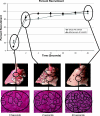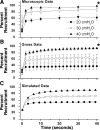The role of time and pressure on alveolar recruitment
- PMID: 19074576
- PMCID: PMC2660249
- DOI: 10.1152/japplphysiol.90735.2008
The role of time and pressure on alveolar recruitment
Abstract
Inappropriate mechanical ventilation in patients with acute respiratory distress syndrome can lead to ventilator-induced lung injury (VILI) and increase the morbidity and mortality. Reopening collapsed lung units may significantly reduce VILI, but the mechanisms governing lung recruitment are unclear. We thus investigated the dynamics of lung recruitment at the alveolar level. Rats (n = 6) were anesthetized and mechanically ventilated. The lungs were then lavaged with saline to simulate acute respiratory distress syndrome (ARDS). A left thoracotomy was performed, and an in vivo microscope was placed on the lung surface. The lung was recruited to three recruitment pressures (RP) of 20, 30, or 40 cmH(2)O for 40 s while subpleural alveoli were continuously filmed. Following measurement of microscopic alveolar recruitment, the lungs were excised, and macroscopic gross lung recruitment was digitally filmed. Recruitment was quantified by computer image analysis, and data were interpreted using a mathematical model. The majority of alveolar recruitment (78.3 +/- 7.4 and 84.6 +/- 5.1%) occurred in the first 2 s (T2) following application of RP 30 and 40, respectively. Only 51.9 +/- 5.4% of the microscopic field was recruited by T2 with RP 20. There was limited recruitment from T2 to T40 at all RPs. The majority of gross lung recruitment also occurred by T2 with gradual recruitment to T40. The data were accurately predicted by a mathematical model incorporating the effects of both pressure and time. Alveolar recruitment is determined by the magnitude of recruiting pressure and length of time pressure is applied, a concept supported by our mathematical model. Such a temporal dependence of alveolar recruitment needs to be considered when recruitment maneuvers for clinical application are designed.
Figures



Comment in
-
Making "time" for alveolar recruitment.J Appl Physiol (1985). 2009 Mar;106(3):751-2. doi: 10.1152/japplphysiol.91652.2008. Epub 2008 Dec 31. J Appl Physiol (1985). 2009. PMID: 19118154 No abstract available.
Similar articles
-
Injurious mechanical ventilation in the normal lung causes a progressive pathologic change in dynamic alveolar mechanics.Crit Care. 2007;11(3):R64. doi: 10.1186/cc5940. Crit Care. 2007. PMID: 17565688 Free PMC article.
-
Positive end-expiratory pressure lung recruitment: comparison between lower inflection point and ultrasound assessment.Wien Klin Wochenschr. 2012 Dec;124(23-24):842-7. doi: 10.1007/s00508-012-0303-1. Epub 2012 Dec 11. Wien Klin Wochenschr. 2012. PMID: 23229578
-
Mechanical breath profile of airway pressure release ventilation: the effect on alveolar recruitment and microstrain in acute lung injury.JAMA Surg. 2014 Nov;149(11):1138-45. doi: 10.1001/jamasurg.2014.1829. JAMA Surg. 2014. PMID: 25230047
-
Lung recruitment maneuvers in acute respiratory distress syndrome and facilitating resolution.Crit Care Med. 2003 Apr;31(4 Suppl):S265-71. doi: 10.1097/01.CCM.0000057902.29449.29. Crit Care Med. 2003. PMID: 12682451 Review.
-
How respiratory system mechanics may help in minimising ventilator-induced lung injury in ARDS patients.Eur Respir J Suppl. 2003 Aug;42:15s-21s. doi: 10.1183/09031936.03.00420303. Eur Respir J Suppl. 2003. PMID: 12945996 Review.
Cited by
-
Predicting ventilator-induced lung injury using a lung injury cost function.J Appl Physiol (1985). 2016 Jul 1;121(1):106-14. doi: 10.1152/japplphysiol.00096.2016. Epub 2016 May 12. J Appl Physiol (1985). 2016. PMID: 27174922 Free PMC article.
-
Does airway pressure release ventilation offer new hope for treating acute respiratory distress syndrome?J Intensive Med. 2022 Mar 28;2(4):241-248. doi: 10.1016/j.jointm.2022.02.003. eCollection 2022 Oct. J Intensive Med. 2022. PMID: 36785647 Free PMC article. Review.
-
Detection of inspiratory recruitment of atelectasis by automated lung sound analysis as compared to four-dimensional computed tomography in a porcine lung injury model.Crit Care. 2018 Feb 24;22(1):50. doi: 10.1186/s13054-018-1964-6. Crit Care. 2018. PMID: 29475456 Free PMC article.
-
Regional Behavior of Airspaces During Positive Pressure Reduction Assessed by Synchrotron Radiation Computed Tomography.Front Physiol. 2019 Jun 7;10:719. doi: 10.3389/fphys.2019.00719. eCollection 2019. Front Physiol. 2019. PMID: 31231245 Free PMC article.
-
Purinergic signalling links mechanical breath profile and alveolar mechanics with the pro-inflammatory innate immune response causing ventilation-induced lung injury.Purinergic Signal. 2017 Sep;13(3):363-386. doi: 10.1007/s11302-017-9564-5. Epub 2017 May 26. Purinergic Signal. 2017. PMID: 28547381 Free PMC article. Review.
References
-
- Acute Respiratory Distress Syndrome Network. Ventilation with lower tidal volumes compared with traditional tidal volumes for acute lung injury, and the acute respiratory distress syndrome. The Acute Respiratory Distress Syndrome Network. N Engl J Med 342: 1301–1308, 2000. - PubMed
-
- Alencar AM, Buldyrev SV, Majumdar A, Stanley HE, Suki B. Avalanche dynamics of crackle sound in the lung. Phys Rev Lett 87: 088101, 2001. - PubMed
-
- Allen GB, Suratt BT, Rinaldi L, Petty JM, Bates JH. Choosing the frequency of deep inflation in mice: balancing recruitment against ventilator-induced lung injury. Am J Physiol Lung Cell Mol Physiol 291: L710–L717, 2006. - PubMed
-
- Amato MB, Barbas CS, Medeiros DM, Magaldi RB, Schettino GP, Lorenzi-Filho G, Kairalla RA, Deheinzelin D, Munoz C, Oliveira R, Takagaki TY, Carvalho CR. Effect of a protective-ventilation strategy on mortality in the acute respiratory distress syndrome. N Engl J Med 338: 347–354, 1998. - PubMed
-
- Amato MB, Barbas CS, Medeiros DM, Schettino Gde P, Lorenzi Filho G, Kairalla RA, Deheinzelin D, Morais C, Fernandes Ede O, Takagaki TY, et al. Beneficial effects of the “open lung approach” with low distending pressures in acute respiratory distress syndrome. A prospective randomized study on mechanical ventilation. Am J Respir Crit Care Med 152: 1835–1846, 1995. - PubMed
Publication types
MeSH terms
Grants and funding
LinkOut - more resources
Full Text Sources

